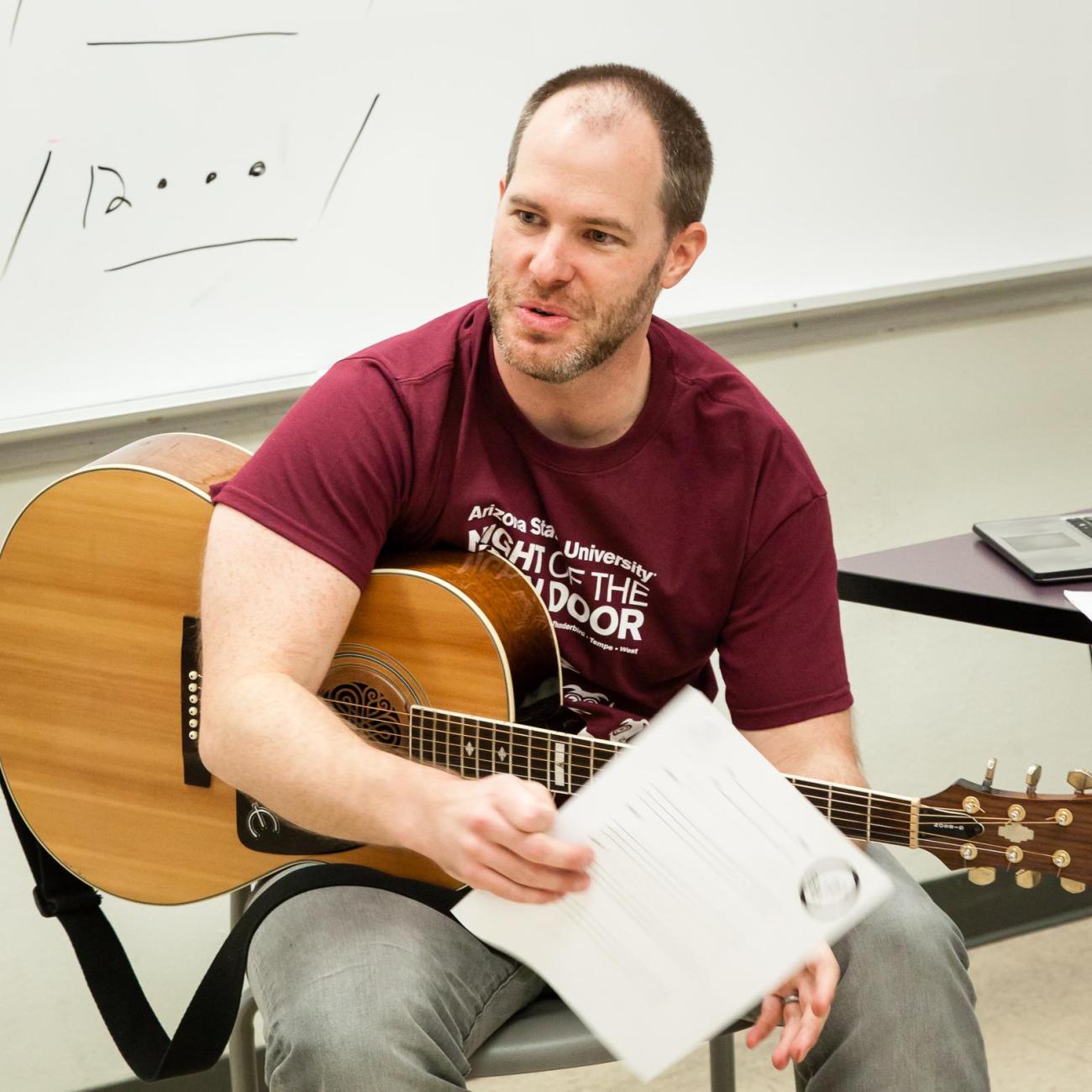Serendipity, Hard Work Lead to Book Deal for Doctoral Student Jason Griffith
As a high school teacher in Pennsylvania, Jason Griffith made a strong case for creative nonfiction in the writing classroom. Part of a secondary curriculum which traditionally focused on fiction, Griffith saw great value in engaging students with nonfiction texts—and ultimately, having them write their own creative nonfiction pieces.
As a second-year, full-time PhD student in ASU’s English Education program, Griffith has already published his first book, From Me to We: Using Narrative Nonfiction to Broaden Student Perspectives (Routledge, 2017). Modeling his process of using creative non-fiction texts—and showcasing his students’ voices—From Me to We is a practical book which offers ways to engage students in reading and writing using narrative nonfiction. According to Routledge.com, “By engaging adolescents in narrative, literary, or creative nonfiction, they can cultivate a greater understanding of themselves, the world around them, and what it means to feel empathy for others.” The book guides teachers towards structuring a reading unit around a narrative nonfiction text—and then developing lessons and activities for students to create their own personal essays. The book’s activities are geared towards 7-12 graders, and samples are taken from Griffith’s high school classes.
Motivations…and Good Timing
According to Griffith, he had been teaching in a district where, “For a whole bunch of years, they had been re-writing the curriculum. The curriculum had a lot of old fiction.” Griffith had been personally getting into creative nonfiction and was looking for a way to bring that into his teaching. Griffith sold his ideas to the district by stating that he could teach a memoir project to high schoolers as the culmination of a reading unit (also centered on nonfiction texts). In fact, Griffith makes a larger argument for creative writing in secondary curricula by emphasizing that “students can demonstrate knowledge of literary elements by using them in their own writing.”
When talking about the book deal, Griffith was all smiles. He described how he had done book review work for Eye on Education (now Routledge) early in his teaching career. The acquisitions editor he had worked with had approached him later about doing a book; as they sat discussing possible ideas at the 2014 NCTE conference, Jacqueline Woodson (who had just won the National Book Award for Brown Girl Dreaming) walked up to the table and said to Griffith, “Hey, don’t I know you?” Griffith had just met her at Penn State, Harrisburg at a small book signing and had brushed shoulders with her at the NCTE conference. He told me: “The coolest moment was when I got to introduce Jackie Woodson to the editor of Eye on Education.”
Inside the Book: Showcasing Practical Application and Students’ Voices
From then on, the project was in the works. Griffith says, “the book was happening as the unit was happening.” That is, materials for the book were developing as he was teaching the nonfiction unit; students were excited to be the first group to use the new materials. Griffith used Steve Lopez’s memoir, The Soloist, for example (and also had students read the newspaper article and watch the film that centered on the story). Griffith emphasized how the first half of From Me to We models the process of discussing content but also how different genres involved different rhetorical moves. Griffith’s teaching also stresses how “texts don’t exist in isolation.” The modeling in the book is practical, and as Griffith says, “teachers can plug and play”—adapting the process and sequence of activities to other texts.
The second half of the book also emphasizes contextualization of stories—but now with student memoirs. The book describes teaching activities such as empathy check-ins, building community, and giving students the option to share with other students or just the teacher. In the book Griffith builds on research that writing expressively can lead to healing. As Griffith thumbed through the book, he shared a range of topics. Students had written about coming out of the closet. One student wrote about being disowned for having an abortion. One religious student wrote about marching at an anti-abortion rally. Another wrote about having to attend her grandmother’s funeral on her birthday. Still others wrote about cutting and issues with their parents and families. Larger questions that Griffith’s teaching—and his book—highlight are things like asking students, “how would the story change if someone else told it?”
His teaching also underscores the difficult question of students being reluctant to tell their own stories. Griffith expressed how he “put student knowledge front and center” by showcasing examples, quotes, and reactions. Near the end of the book, Griffith also includes two extensive interviews that focus on the value of the memoir genre. One interview is with MK Asante, a professor at Morgan State University, author of the bestselling memoir Buck, a film-maker, and a rapper; the other is with Johanna Bear, one of Griffith’s former students and nationally recognized nonfiction writer.
Looking Forward
Griffith was enthusiastic when he talked about his hope to have a meaningful impact on pre-service teachers. As a Teaching Associate at ASU, he has taught English 480 (Teaching Writing Methods)—and through the combination of his book, scholarship, and belief that nonfiction can have strong benefits in students’ lives—Griffith hopes he will help improve practice in future teachers. He states: “I see teaching as an exercise in student empowerment” and believes in teaching students how to “take control of their narratives.” In an age of standardized testing, Jason also makes the argument that if teachers are teaching really good material, they are going to naturally hit the standards: “Even within the confinements of standards, students still can have some measure of freedom.”
Griffith dedicated From Me to We to his former teacher and mentor Sue F. Johnson—a professor at Indiana University at Pennsylvania—who recently passed away. Johnson supervised Griffith during his student teaching and played a significant role in his personal development. Griffith expressed that “he hopes to contribute to the field what she did for him.” Griffith is also grateful to his wife Kelly for her graphic contributions to the book and to his current mentor, ASU Professor Jim Blasingame.
Griffith celebrated publication of his book at a launch event at Changing Hands Bookstore in Tempe last December 8.
—Meghan Bacino
Image 1: Book cover image courtesy Routledge.
Image 2: Jason Griffith. Courtesy photo.
Image 3: Jason Griffith encourages students to write using multiple methodologies and genres, including music. He gave a workshop at ASU's Night of the Open Door 2017 on how to write "12-Bar Blues." Photo by Bruce Matsunaga



